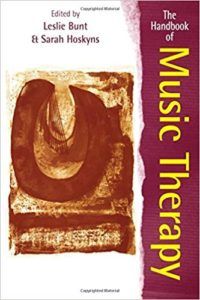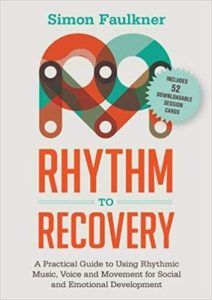15 Music Therapy Activities and Tools
 Sometimes, good coffee and good music are all that we need to unwind. Music touches all aspects of our lives – physical, emotional, psychological, and behavioral.
Sometimes, good coffee and good music are all that we need to unwind. Music touches all aspects of our lives – physical, emotional, psychological, and behavioral.
As a therapy, music is a proven way to reduce stress and to get into a mindful state of consciousness.
Music therapy includes listening, communicating, and understanding. It is a popular method used in hospitals, educational institutions, and other clinical settings to ease clients and make them comfortable.
Psychologists believe that music therapy improves the quality of life (Scott, 2018). From pain to personal loss, attentional disorders to relationship issues, music therapy is one fix that suits all.
Professor Suzanne Hanser of Berklee College of Music said that music therapy serves five significant purposes:
- Shifting one’s attention from problems to solutions.
- Offering a rhythmic structure for relaxation and breathing.
- Helping clients visualize positive imagery that evokes pleasure and happiness.
- Helping them achieve a deep state of relaxation.
- Changing mood.
Music therapy stands undisputed as a heal for negative stress and burden. In this article, we will take a look at some of the most useful resources on music therapy for kids and adults. With a range of exercises, activities, and kinds of music, the tools mentioned in the sections below can be a great start to uncovering the real benefits of music therapy on all levels.
Before you read on, we thought you might like to download our three Positive Psychology Exercises for free. These science-based exercises will explore fundamental aspects of positive psychology including strengths, values and self-compassion and will give you the tools to enhance the wellbeing of your clients, students or employees.
This Article Contains:
- What are Music Therapy Activities and Tools?
- 3 Music Therapy Techniques
- A Look at Music Therapy Interventions
- 3 Examples Of Music Therapy in Action
- Common Questions on the Application of Music Therapy
- 3 Music Therapy Activities and Exercises
- Application Ideas for Kids
- 2 Music Therapy Worksheets
- 2 Questionnaires (Incl PDF)
- 2 Books on Music Therapy
- A Take-Home Message
- References
What are Music Therapy Activities and Tools?
Music therapy is an expressive art therapy. Whether you are writing a song, listening to it, or singing alongside – music therapy in any form requires some form of communication and expression.
Music therapy is mostly conducted under supervision, where the therapist uses specialized tools or other mechanisms to implement the program successfully.
For example, musical instruments like the guitar or piano are popular music therapy tools. Some forms of music therapy also involve imagery, where the therapist gently guides the client to imagine himself in a pleasant situation and plays soothing music to create the right ambiance for it.
There are numerous tools and activities that music therapists use.
Some of them are:
A musical instrument
Clients love to hear their therapist play and sing along. Having a guitar, ukulele, keyboard, or harp, is excellent for brightening up the session. It brings in an immediate sense of joy and works brilliantly for youngsters in music therapy.
A speaker
Playing music on a good speaker is ideal for group therapy. It creates a sense of livelihood and encourages clients to participate in the process. Besides, it also helps the therapist to make sure he is audible to all.
A screen for visual activities
When using visual imagery to accompany the music, therapists often keep a tablet or other devices to project the image on the screen. Besides keeping clients engaged throughout the session, visual tools act as a catalyst in enhancing the positive impact of music on our mind.
Paper and pen
Many music therapists keep pen and paper for recording and managing feedback. It is also used in songwriting activities or sentence completion games where the clients express themselves through words.
The core purpose of music therapy is to strengthen one’s emotional skills and calls for a positive shift in mindset. Various methods or music therapy activities are used by professionals to meet these goals (Kimberley 2012).
For example, some music therapy activities include:
- Writing and singing songs.
- Improvising on songs and music pieces.
- Playing a musical instrument.
- Using musical devices and technology.
- Listening to music (with and without visual imagery).
- Exchanging information through music.
3 Music Therapy Techniques
What music therapy techniques do you know? We reflect on three techniques.
1. Drumming
Drumming is an excellent music tool for inducing light-hearted fun, positive addiction, and unhindered engagement. Scientists believe that drumming activities increase cellular activity that helps the body fight against neurological and endocrinological disorders.
Besides improving bodily functions, drumming also has a positive social connotation and brings people together as part of a group.
There are no rules in drumming interventions. Clients are free to choose their way and play the instrument as they like.
Rick Allen, a famous drummer and the founder of the Raven Drum Foundation, suggested that some immediate benefits of drumming include:
- Reduction of stress, trauma, and anxiety.
- Controlling symptoms of chronic pain.
- Revitalizing the immune system.
- Creating a sense of social connection.
- Emotional catharsis or release of bottled-up anger and aggression.
- Providing scope for self-realization and introspection.
2. Singing
Singing is a universal music therapy technique that is suitable for clients of all ages and backgrounds. It has been incorporated in various forms and activities and is a widely used music therapy tool today. Many psychologists call singing the ‘mega-vitamin’ for the brain.
Studies have shown that listening to songs or singing along with them helps in repairing damaged brain tissues. This is a reason why singing is a crucial part of treating Parkinson’s disease, dementia, or Alzheimer’s (Gerdner and Swanson,1993).
3. Vibro-Acoustic Therapy
Vibro-Acoustic Therapy or VAT is a scientific approach of combining low-frequency vibrations with the resonations of slow-paced music. The International Society of VAT mentioned that ‘sound waves helps in circulating positive energy throughout the body.’ It activates the body and allows it to use the inbuilt repair mechanisms to calm the mind and body.
A Look at Music Therapy Interventions
Music therapy interventions are broadly categorized as active interventions and receptive interventions. In general, all forms of music therapy interventions use the power of tunes and sound waves to penetrate the human mind and help it attain a peaceful state. Whether a person is creating music, playing it, or listening to it, the instant emotions that the process evokes help bring about the positive shift in focus.
Active music interventions are the ones where clients and therapists are equally involved in the therapeutic process. Activities such as dancing, group singing, solo performances, or musical games are ideal examples of active interventions of music therapy.
In receptive or passive interventions, clients are mostly listeners more than performers. These interventions include music relaxation therapies, mindful music meditation, or the like.
A popular music intervention that many neuroscientists rely on is Neurologic Music Therapy or NMT. It is a scientific technique that records brain functions before and after exposure to relaxing music to induce desirable changes in the client. NMT is a therapy of choice for helping clients with neuro-linguistic troubles, and it also helps in developing motor skills in children and young adults. (Koelsch, 2009).
3 Examples Of Music Therapy in Action
The earliest evidence of a musical instrument was a bone flute that was arguably about 40,000 years old. The in-grained impact of music therapy that more or less all of us experience is partly due to these ancient links of music and human living (Rolvsjord, 2010).
Music therapy has been around since the Stone Age. Ancient civilizations and indigenous cultures like the Aborigines of Australia and some African tribes used singing and musical group activities to pray, celebrate, or sail through tough times (such as drought, flood, or extreme weather conditions).
The Ancient Greek civilization also leaves traces of how they incorporated music into their lives and believed that it is the only way to restore the peace of mind and body.
Musings of Plato and Pythagoras have several indications of how the Greeks tried to support each other through music and encouraged music education and awareness in their communities (Pavlicevic and Ansdell, 2004; Stige, 2002; 2003; Stige, Ansdell, and Pavlicevic, 2010; Stige and Aaroe, 2012).
Another prominent example of a real-life application of music therapy is in autism treatment. Autistic children, who have impaired social and cognitive abilities, respond prominently better to musical stimuli than other modes of communication. It captures their attention and sustains it for a longer duration.
Studies have also shown that teaching differently-abled children daily duties through musical actions helps in imprinting the information permanently and internalizing the information sooner.
Why I want to change the world with music therapy – Erin Seibert
Common Questions on the Application of Music Therapy
Jeff Peterson, President of the UCSF Benioff Children’s Hospital, said that most clients and caregivers, before participating in music therapy sessions come with several queries about the usefulness of music therapy.
Some common questions that people ask include:
- What is music therapy?
- How does it help in improving health?
- How often do we need to practice it?
- How does it impact on mood and emotions?
- Where can we practice it?
- Who can give us more information about music therapy?
- Are music therapy and music relaxation the same thing?
Many online resources and blogs give us an idea of what we should know before signing up for music therapy and who we should talk to. You can have a look at these articles by our writers that beautifully explain music therapy, its background, and implications in real life.
3 Music Therapy Activities and Exercises
Music therapy research is at its peak, and many effective musical interventions and strategies are uniquely designed to suit our purposes. Below is a list of popular music therapy group activities and other interventions that you might want to know about.
1. Music Bingo
Music Bingo is a cognitive music activity that improves memory and reality orientation. It is a preferred method for adult interventions and is often used in association with other forms of therapy to improve mental health.
The activity involves making cards where each participant draws a song, and others sing it after guessing the name right. It can be played in pairs or as a group, and works great for people with poor memory skills.
2. Music Relaxation
Music relaxation is a well-known music therapy for mindfulness and meditation. The primary purpose of music relaxation is to induce a calm state where the mind can relax, and the muscles can loosen up to shed the pent-up stress.
Music relaxation is a vital component in many yoga retreats, where instructors moderate the room lights and minimize any external distraction before playing the tune. It is also a great way to unwind ourselves every day and helps improve emotional resilience over time.
3. Music Selection
Music selection is used for adolescents or clients with disturbances in emotional and self-regulation. The process involves letting clients choose a piece of music that they are familiar with. Self-selected pieces of music evoke emotions and bring back memories that might be associated with it.
Music selection often accompanies guided visual imagery where the therapist urges the client to imagine himself in a pleasant environment while the music continues to play in the background. It is a meditative practice that induces ultimate self-awareness and acceptance.
Application Ideas for Kids

Music therapy motivates kids of all ages and is an excellent intervention for managing childhood depression, impulse control problems, and attention-related disorders (Gold, Voracek, and Wigram, 2004).
Musical interventions for children are used in schools, private counseling practices, medical facilities, and foster homes. The common goal is to uplift their mood and help them manage their distress effectively.
Most researchers agree that music therapy for children works best in a group setting. Performing as part of a team helps them form connections to peers and overcome any loneliness they have been facing.
Whether the interventions are conducted in schools or other facilities, group activities help in:
- Knowing others having similar problems and developing empathy.
- Communicating and motivating each other in the group.
- Expressing and reacting spontaneously to the stimuli.
- Building connections and helping each other overcome their loneliness.
- Improving listening skills, readiness, and reaction times.
- Building secure coping mechanisms and self-confidence.
Involving family and teachers in music therapy for kids is also an excellent option for rebuilding the relationships they share with their elders. Musical exercises help them come closer to each other and explore happiness by spending undistracted time with each other.
2 Music Therapy Worksheets
There are a few interesting music therapy worksheets in our toolkit, and we briefly describe them below.
Using Music to Express Feelings
As mentioned earlier, music therapy calls for emotional catharsis and self-expression. The ‘Using Music to Express Feelings‘ worksheet helps clients open up about their innermost feelings through some musical expressions.
The exercise is simple and contains the following steps. It is subjective and self-storable, so there are no right or wrong answers in this. Below is a brief description of the worksheet, and you can learn more about it from the Positive Psychology Toolkit©.
Instructions – Choose three songs that you think describe your situation and feelings right now. For each of the songs you chose, answer the following questions, and be true to yourself. Remember that there are no right or wrong answers here.
1. What are the titles of the songs?
____________________________________________________________
2. What comes to your mind when you hear the songs?
____________________________________________________________
3. How do they make you feel?
____________________________________________________________
4. What part of each song is the most important to you, and why?
____________________________________________________________
Draw What You Hear Worksheet
This worksheet is used in several settings for both individual and group purposes. The task is simple and uses the following steps:
- Clients rate their listening skills at the beginning of the session.
- The therapist then exposes them to a few musical pieces and asks them to attend to each carefully.
- At the next step, each participant gets a worksheet (shown below), where they either write, draw, or journal what they felt after listening to the pieces of music.
| Sample Worksheet | ||
|---|---|---|
| Song 1 ————————————— ————————————— ————————————— |
Song 2 ————————————— ————————————— ————————————— |
Song 3 ————————————— ————————————— ————————————— |
| Song 4 ————————————— ————————————— ————————————— |
Song 5 ————————————— ————————————— ————————————— |
Song 6 ————————————— ————————————— ————————————— |
2 Questionnaires (Incl PDF)
Use the following surveys to assess your clients.
1. Music Therapy Questionnaire Survey
The Music Therapy Questionnaire Survey is an assessment that is usually used at the beginning or the end of each session. The questionnaire is objective; a brief overview of it is here below.
| Statements | Responses |
|---|---|
| Is your choice of music dependent on your mood? | Yes/No |
| Do you think music is an alternative therapy for depression or anxiety? | Yes/No |
| How often do you spend time listening to music daily? | Never/Rarely/Occasionally/Frequently/Very frequently |
| Do you believe in the effectiveness of music as a therapy? | Yes/No |
2. Children’s Music Therapy Questionnaire
The Children’s Music Therapy Questionnaire is an adaptation of the adult version. The worksheet is represented with bright images and pictorial representations that children should find easy and fun to do. The questionnaire is briefly illustrated below, and you can download the full version as well.
| Children’s Music Therapy Questionnaire | |
|---|---|
| Which of the following instruments have you used in your music therapy sessions? | 1. Guitar 2. Piano 3. Flute 4. Harp 5. Drums 6. CDs and DVDs |
| How does the music therapy sessions make you feel? | 1. Happy 2. Sad 3. Neutral 4. Something else |
| Do you think music therapy can help you at school? | 1. Yes 2. No |
| Would you like to change anything about the music therapy sessions? | 1. Yes 2. No |
2 Books on Music Therapy
These Music Therapy books are great tools to improve your knowledge and skills.
1. The Handbook of Music Therapy – Leslie Bunt, Leslie Hoskyns, and Sangeeta Swami

The book is divided into four segments, each exploring a crucial aspect of music therapy such as its evolution, historical implications, clinical contributions, practical applications, and professional uses.
It comes with real-life examples and case studies and is suitable for professionals, therapists, or anyone interested to learn more about the fundamentals of musical interventions in psychotherapy.
Find the book on Amazon.
2. Rhythm to Recovery: A Practical Guide to Using Rhythmic Music, Voice and Movement for Social and Emotional Development – Simon Faulkner and James Oshinsky

The book contains over 100 drills that are suitable for different age groups and is undoubtedly an excellent reference for professional use. It offers meaningful insight on childhood and adolescent problems and uncovers unique ways of using music to address those issues.
Find the book on Amazon.
A Take-Home Message
Music reduces pain and brings us closer to ourselves. It is one of the best remedies for beating stress and loneliness, and also gives us the strength to face and express the strong emotions that guide most of our actions.
Using music as a relaxation technique, individual, or group intervention can bring desired changes in terms of cardiac functioning, blood pressure levels, and overall body functions. Whether you are an active listener or an active performer, music, in any form, will change your life for the better.
As Jean Richter said, and we all at some levels would agree to it:
Music is moonlight in the gloomy nights of our lives.
Continue Reading: 17 Best Drama Therapy Techniques, Activities & Exercises
We hope you enjoyed reading this article. Don’t forget to download our three Positive Psychology Exercises for free.
- Blood, A., & Zatorre, R. J. (2001). Intensely pleasurable responses to music correlate with activity in brain regions implicated in reward and emotion.
- Forsblom, Lantinen, Särkämö, and Tervaniemi, (2009). Therapeutic role of music listening in stroke rehabilitation.
- Guetin, Picot, Pommie, and Djabelkir, (2009). Effect of music therapy on anxiety and depression in patients with Alzheimer’s type dementia.
- Klassen, Liang, and Hartling, (2008). Music for pain and anxiety in children undergoing medical procedures.
- Koelsch, S. (2009). A Neuroscientific perspective on music therapy.
- Levy, Jillian (2017). Music therapy: Benefits and uses for anxiety, depression and more.
- Scott, Elizabeth (2018). Music relaxation: A healthy stress management tool.
- Smith, Yolanda (2018). Types of Music Therapy.
Let us know your thoughts
Read other articles by their category
- Body & Brain (49)
- Coaching & Application (57)
- Compassion (26)
- Counseling (51)
- Emotional Intelligence (24)
- Gratitude (18)
- Grief & Bereavement (21)
- Happiness & SWB (40)
- Meaning & Values (26)
- Meditation (20)
- Mindfulness (45)
- Motivation & Goals (45)
- Optimism & Mindset (34)
- Positive CBT (28)
- Positive Communication (20)
- Positive Education (47)
- Positive Emotions (32)
- Positive Leadership (18)
- Positive Parenting (4)
- Positive Psychology (33)
- Positive Workplace (37)
- Productivity (16)
- Relationships (46)
- Resilience & Coping (36)
- Self Awareness (21)
- Self Esteem (37)
- Strengths & Virtues (31)
- Stress & Burnout Prevention (34)
- Theory & Books (46)
- Therapy Exercises (37)
- Types of Therapy (64)





What our readers think
I facilitate an 8 hr restorative justice workshop in a youth detention facility with some of the most violent young people in our state. I’ve recently started implementing music in the middle of our workshop and it has already had a positive effect. To the point that we are starting a music writing and recording class at the facility. If this goes well we will offer the class at other facilities in the state. The info given here is VERY helpful for what we are doing. I’d love to stay tapped in here.
Thank you for the article!
I would love to try the music bingo. But it is not totally clear to me how it works?
Thank you in advance!
Hi Bente,
I’m glad you found the article about Music Bingo interesting and that you’re keen to try it!
Here’s how it works:
Each participant receives a card with different songs listed. Then a song is played or a hint is given about a song.
Participants try to identify the song and if they have it on their card, they mark it. Eventually, the first person to complete a row or pattern (as decided before the game starts) and shout “Bingo!” is the winner.
Hope this helps!
Warm regards,
Julia | Community Manager